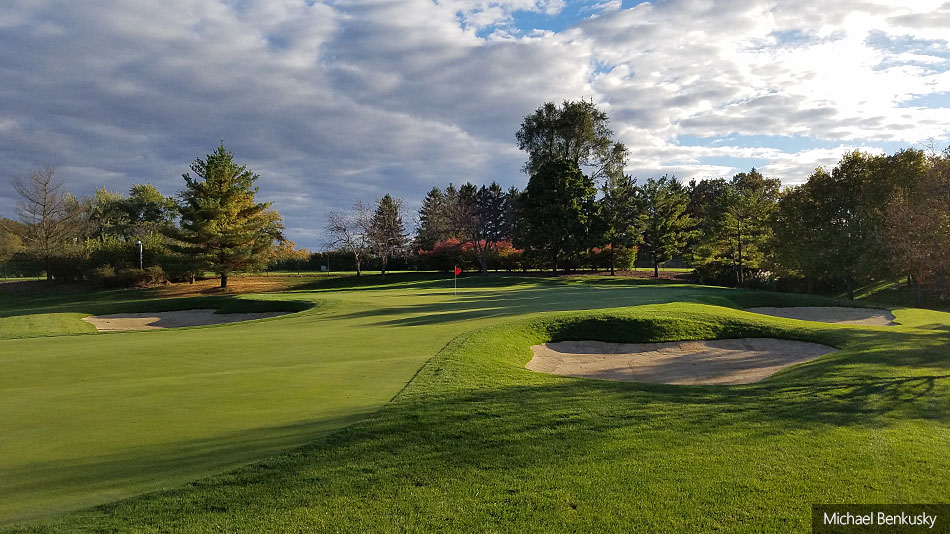Mike Benkusky, ASGCA (Michael J. Benkusky, Inc., Golf Course Architect), has begun work on St. Charles Country Club, near Chicago, where he is working on holes designed by Tom Bendelow in 1926…and others designed some six decades later, making for a most unique project.
Golf Course Architecture reports:
“The original course was bisected by IL Route 25, with the old clubhouse on the west side,” said Benkusky. “In 1987 the club sold the east section of land and moved the clubhouse and seven golf holes north of Country Club Road. These holes were designed by David Gill. While this design maintained an 18-hole golf course, the design styles of the two architects varied.”
Benkusky proposed combining the two styles into one, cohesive 1920s-style course. “Once that decision was made, the plan began to take shape. That involved rebuilding all the bunkers to the same style, squaring off the tee complexes, removing trees to open vistas and improve agronomics, and expanding the greens on the original Bendelow holes.”
“The biggest challenge, and enjoyment, has been designing to combine two significantly different design philosophies into one style,” said Benkusky. The architect notes that little of the original Bendelow design had remained. “All the greens and bunkers had been rebuilt in past renovations. However, that part of the golf course does have an ‘older’ feel and we were able to use that as inspiration. The land is flatter, and the golf holes have greens that run in from the approach area. These holes also contain less bunkers per hole.
“The Gill design, where we have concentrated our current work, has more bunkers. Getting those to tie together has been the key. The first hole, for example, had eight bunkers: two on each side of the fairway and two on each side of the green. The new design reduced the number to three, two in the fairway and one at the green.
“This reduction in sand not only allows for less area to maintain, but also improved the design strategy of the hole. This same philosophy was used on the seventh, tenth and eleventh, which are all original Gill-designed holes.”
Work began in 2016 and the club has now rebuilt all bunkers on five holes. “On the Bendelow side we’ve rebuilt and expanded the green on the second hole along with new sand bunkers throughout the hole,” said Benkusky.
Golf course superintendent Chuck Barber said: “Improving playability characteristics is a chief concern. Many of our bunkers, for example, still have clay tile drainage and drain very poorly. Also, steep sand flash faces with no liner and poor-performing sand are very prone to washout. Eliminating sheet flow of water into the bunker and redirecting it in to the surrounds saves us from holding onto water and from contaminating the sand. The club wants the bunkers to be as ‘the same’ as possible and they don’t want to wait 24 to 48 hours before the sand dries sufficiently to be put back in place and raked.”
The club has also completed tree removal and relocation and work on tee complexes. Benkusky and Barber have been supported by assistant superintendent Jason Kahlstorf, general manager Ken Vranek and St. Charles CC staff.
The club plans to complete work on the remaining thirteen holes in autumn 2019, working with Leibold Irrigation’s John Leibold and Kevin Steineke.
Benkusky said he was excited for the final completion of the plan. “The membership is ready to have a golf course that flows as one from the first tee to the eighteenth green,” said Benkusky. “Once complete, I believe we will achieve our goal and it will be very hard for someone to distinguish that the original course was completed by two different architects, 60 years apart.”
Barber concluded: “Michael is patient, diligent and guided by good instincts as a golfer, builder and architect. He wants things to be right, he doesn’t need to be right. Michael realises that a plan is only a piece of paper and that once dirt starts to move the plan can change. His adaptability and his ability are commendable when given circumstances that are so critical to the parties involved. The grounds and greens department, golf course staff, PGA Staff, clubhouse staff, and our members all have a vested interest in his ability as an architect. He handles interaction with everyone with patience, understanding and intelligence. He happens to be an exceedingly nice man with good ideas and makes it easy to be happy with the outcome.”

